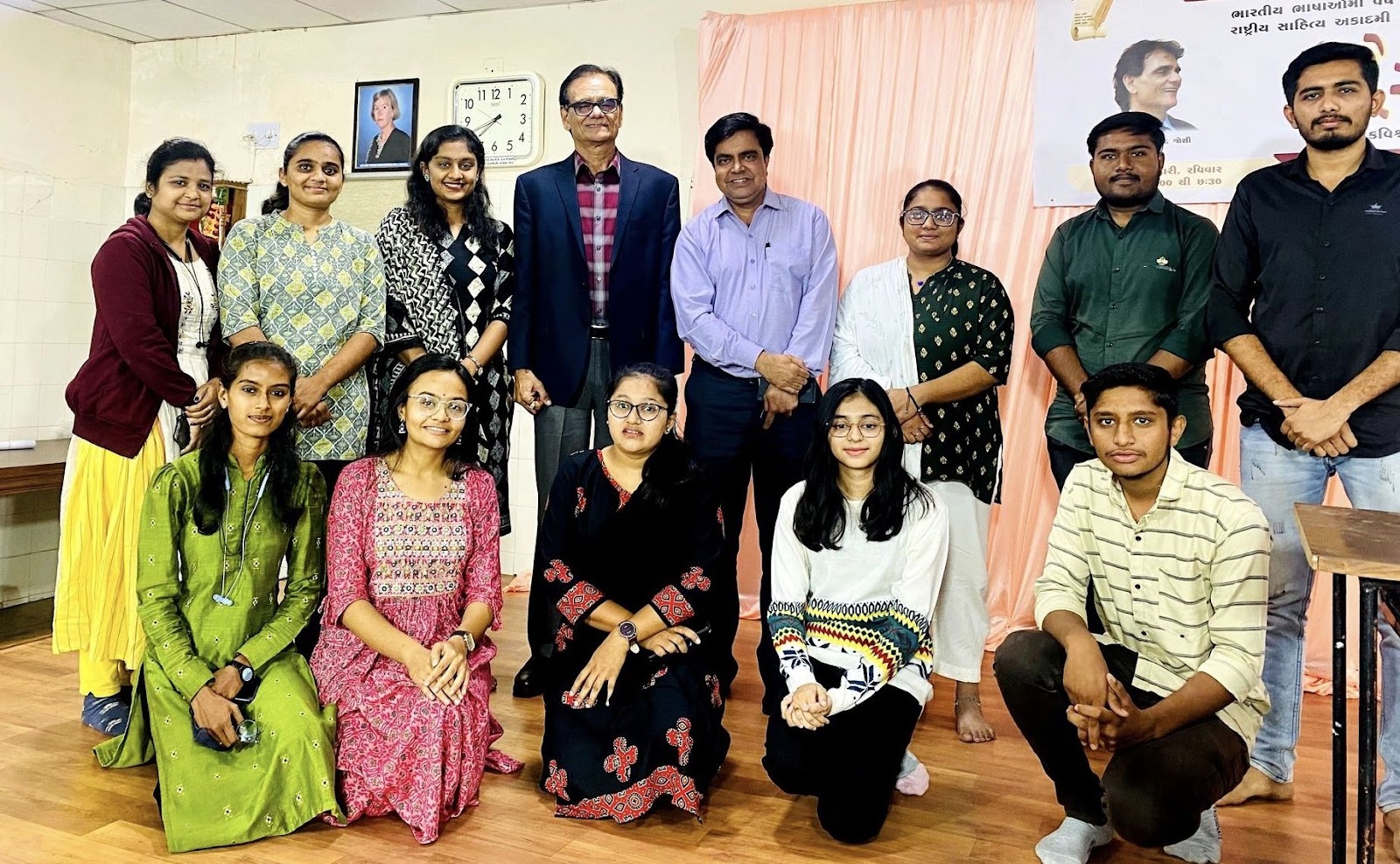‘સૈરન્ધ્રી’- વિનોદ જોશી
સૈરન્ધ્રી એટલે અજ્ઞાતવાસમાં વિરાટનગરમાં વિરાટરાજાની રાણી સુદેષ્ણાની દાસી તરીકે રહેલી દ્રોપદી. ‘મહાભારત’ મહાકાવ્યના આમ તો ઘણા બધા રીટેલીંગ્સ થયા છે જે મહાભારતના મૂળકથાનકના પાત્રોને એક નવી દ્રષ્ટિ અને નવા મનોભાવ સાથે રજૂ કરે છે, જેમાંનું એક ‘The Curse or Karna’ અનુસ્નાતક અભ્યાસક્રમના ભાગરૂપે ભણવામાં આવ્યું હતું. પણ વિનોદ જોશીનું ‘સૈરન્ધ્રી’ આનાથી જુદું છે અને તેથી જ રમ્ય અને આસ્વાદ્ય છે.
‘સૈરન્ધ્રી’ને ભારતીય સાહિત્ય અકાદમી દ્વારા 2023માં ગુજરાતી ભાષાની સર્વશ્રેષ્ઠ કૃતિ તરીકે પસંદ થયાના સંદર્ભમાં ‘કવિતાકક્ષ’ દ્વારા યોજાયેલ કાવ્યપઠન પૂર્વે આ પ્રબંધકાવ્યના કવિ શ્રી વિનોદ જોશીએ કહ્યું કે, “મહાભારતમાં વેદ વ્યાસે જે કહ્યું તે મારે અહીં કહેવું નથી, અને મારે જો એ જ કહેવું હોત તો હું આ કાવ્ય ન લખત.” આ કાવ્ય મહાભારતનું નથી, દ્રૌપદીનું પણ નથી, પણ મહાભારતના સૌ પ્રચલિત પાત્રો અને કથાના પાયા વડે - પાયા ઉપર મનુષ્યમાત્રનું કાવ્ય છે. આ કાવ્યમાં ‘મહાભારત’માં દ્રૌપદી કે સૈરન્ધ્રીની જે વાત છે તે નથી. અહીં સૈરન્ધ્રીના પાત્ર દ્વારા વ્યક્તિની ખોવાયેલ ઓળખ કે સ્વની શોધ અને આપણી અંદર ચાલતા દ્વન્દ્વની વાત છે. કવિ કાવ્યના નિવેદનમાં લખે છે કે "આપણને સહુને પોતપોતાના કુરુક્ષેત્ર અને પોતપોતાના યુદ્ધ હોય છે. અહીં એવું જે કંઈ છે તે સૈરન્ધ્રીનું છે."
આ કાવ્ય સ્મૃતિ, સ્વપ્ન અને કલ્પનાના સ્તરોમાં વહેચાયેલું છે જે દ્વારા ભાવકને વિસ્મિત કરે છે અને આનંદ આપે છે.
કાવ્યનું પઠન કરતી વખતે અમુક ચોપાઈ અને દોહરા મનમાં સતત રમ્યા કરે છે જેનું કારણ સમયાંતરે સૈરન્ધ્રી દ્વારા અનુભવાયેલ- કહેવાયેલ શબ્દો છે, જે ખરેખર તો આપણા અસ્તિત્વના જ પ્રશ્નો છે તેવું હું માનું છું. સૈરન્ધ્રી વારંવાર પોતાની જાતને પૂછે છે કે પોતે દ્રુપદસુતા અને પાંડવોની પત્ની છતાં પણ એક દાસી? શું ખરેખર આ એ જ દ્રોપદી છે જેના માટે મત્સ્યવેધ સ્વયંવર યોજાયો હતો?
કાવ્યની શરૂઆતમાં જ કવિ વર્ણવે છે,
“વિવશ સાંજ, નભ નિરાલંબ,
નિસ્પંદ સમીર નિગૂઢ,
એક યૌવના નતમુખ ઊભી,
વ્યગ્રચિત સંમૂઢ.”
“હતી નામ રટતી નિજનું -
સૈરન્ધ્રી શ્વાસેશ્વાસ,
હસ્તિનાપુરની મહારાણી,
એ તો કેવળ ભાસ.”
પેહેલા સર્ગમાં જ્યારે રાણી સુદેષ્ણા સૈરન્ધ્રીને પોતાનો કક્ષ છોડી જવા કહે છે ત્યારે કવિએ કરેલું આલેખન અદ્ભુત છે.
“નિત્ય નિજત્વ અવાંતર જોવું,
અંતરિયાળ પડ્યું આ હોવું.”
“પહેર્યો પરિચય પણ આભાસી.”
“દ્રુપદસુતા પણ હું અણજાણી.”
સૈરન્ધ્રીની આ ખોવાયેલી ઓળખ કાવ્યમાં સતત ગુંજ્યાં કરે છે.
“નિજમાં નિજનું સત્ય ન જાણે,
નિજને નિજથી નહીં પિછાણે,
નિસદિન ઢાંકે નિજને પહેલાં,
નહીં કોષ્ટકો નિજના સહેલા.”
-આ નાદ સતત સંભળાય છે.
સૈરન્ધ્રીનું ભૂતકાળને ખંખોળવું એની દબાયેલ લાગણીને દર્શાવે છે, સાથે જ વર્તમાનની પીડા પણ એને વળગેલી છે. વળી, તેમાં સૈરન્ધ્રીને થતું કર્ણનું સ્મરણ કાવ્યને રોમાંચક બનાવી દે છે. મહાભારતમાં દ્રૌપદીનો કર્ણ માટેનો અનુરાગ આલેખાયો નથી, પણ અહીં ગુપ્તવાસની સૈરન્ધ્રીમાં કવિ દ્રૌપદીની સ્મૃતિ અને સ્વપ્નલોકમાં કર્ણને સ્થાન આપે છે અને દ્રૌપદીના હૃદયમાં પણ.
“સ્મરણ રચાયો ફરી સ્વયંવર,
કર્ણ વિરાજે શોભિત સુંદર.”
“વીર કર્ણ મેં વૃથા ઉથાપ્યો”
“પાંડુપુત્રનો મહિમા કીધો,
સૂતપુત્રને ત્યાગી દીધો.”
સૈરન્ધ્રીના કર્ણ પ્રત્યેના અનુરાગને જો આપણે આપણા વાસ્તવિક જીવન સાથે જોડીએ તો હું એવું માનું છું કે એ માત્ર પ્રણય નથી પણ આપણા જીવનની અનેક અતૃપ્ત ઈચ્છાઓ કે જેની કાલ્પનિક તૃપ્તિ આપણે ઇચ્છતા હોય જેમાં સ્મૃતિ અને સ્વપ્ન પણ સંકળાયેલા હોય છે.
“હોય સર્વ પણ કોઈ ન પાસે,
કોઈ દૂર પણ ભીતર ભાસે.”
આ એકલતાની વેળા તેને કર્ણ તરફ દોરી જાય છે.
વળી, કીચકનો પ્રસંગ પણ સુંદર રીતે વર્ણવાયેલ છે. સૈરન્ધ્રીના મનમાં જાગેલ ક્ષણિક ભાવ અને તુરંત એમાંથી પરત ફરી કરાતો કીચકનો પ્રતિકાર પણ એટલો જ મહત્વપૂર્ણ છે.
“કીચક માર્યો એક પણ કીચક હજી અનેક.”
કીચક પર કરેલા આક્રમણ પછી સૈરન્ધ્રી આંતરવેદના અનુભવે છે જેમાં પાંચ પતિઓમાં વહેચાવું અને દ્યુતસભામાં અપમાન વેઠવું જેવી બાબતો એને પોતાને સ્વાભિમાન તરફ જવા પ્રેરે છે.
કીચક પરના આક્રમણ પછીનું કારાવાસનું વિસ્તૃત આલેખન પણ લાક્ષણિક છે.
“કઠ્ઠણ કારાવાસમાં કરતી કૃષ્ણા ખેદ
ભીંતો બદલાઈ ગઈ અન્ય કશો નહીં ભેદ.”
માત્ર ભીંતો બદલાઈ ગઈ પણ અન્ય કશો ભેદ તેની સ્થિતિમાં નથી.
“સહુએ સહુના સ્વાંગમાં નરવી નિજતા ખોઈ,
જ્ઞાત અને અજ્ઞાતમાં અંતર હતું ન કોઈ.”
સૈરન્ધ્રી આ વ્યથાથી એમ છૂટે તેમ નથી. મને લાગે છે કે સાતમો સર્ગ અગાઉના છ સર્ગનો નીચોડ છે. વળી, આ સર્ગમાં એ પણ સૂચવાયું છે કે ખોવાયેલી ઓળખ પોતાના સિવાય ક્યાંયથી મળી શકે તેમ નથી.
“હતી જન્મથી ભડભડ બળતી,
નિજ થી છૂટી નિજમાં ભળતી,
નિત્ય કોઈને મનથી મળતી,
નિજમાં ભળવા પાછી વળતી.”
આ કાવ્ય કવિએ સ્ત્રીને અર્પણ કર્યું છે સાથે જ તેઓ આ નારીવાદી અભિગમથી લખાયું ન હોવાની સ્પષ્ટતા કરે છે. પરંતુ છઠ્ઠા અને સાતમા સર્ગમાં કરેલ સૈરન્ધ્રીનું વર્ણન સ્વમાં સ્થિર થયેલી નારીનું આલેખન કરે છે. સૈરન્ધ્રીએ સ્વબચાવ માટે કરેલ કીચક પર આક્રમણ પણ તેને એક યુયુત્સુ તરીકે સ્થાપિત કરે છે. પણ જો આ અલ્પ અર્થગ્રહણને બાદ કરું તો હું એ સમાપન તરફ આવું છું કે આ કાવ્ય માત્ર સૈરન્ધ્રીનું નથી પણ મનુષ્યમાત્રનું છે જેનું સમર્થન કવિ પણ કરે છે. આપણી અંદર ચાલતા દ્વંદ્વ આપણા સિવાય અન્ય કોઈ જાણી શક્તા નથી અને કદાચ એટલે જ તે દુઃખદાયક પણ છે. ગુપ્તવાસની ઓળખ છતી ન થાય તે હેતુથી તે કોઈને કંઈ કહી પણ શકતી નથી. પતિ સામે જ હોય છતાં એની પત્નીની રક્ષા કરી શકે નહીં, જો ઓળખાય જાય તો ફરી વનવાસ અને અજ્ઞાતવાસ. આપણી પોતાની ઓળખ પણ કેટલી ગુપ્ત હોય છે! સૈરન્ધ્રીની જેમ આપણને પણ આપણે શું છીએ એ સમજાતું નથી. આપણે પણ સ્મૃતિ, સ્વપ્ન અને કલ્પનાથી ગ્રસ્ત રહીએ છીએ.
આ કાવ્યનું અધ્યયન કરતાં સમજાયું શા માટે આ કાવ્ય શ્રેષ્ઠ છે. કવિની કલ્પના આપણને મહાભારતને સાથે લઈ એક નવી જ કથા તરફ લઈ જાય છે અને તેમાં આપણે આપણને પણ જોઈ શકીએ છીએ.
આ કાવ્ય મેં પહેલા પણ વાંચેલું. પણ કવિમુખે કાવ્યપઠન સાંભળવું તો એક લ્હાવો હતો. એમાંય એમની કાવ્યપાઠની છટા કાવ્યને સમજવાની ઘણી અસમંજસ દૂર કરી દે છે. કાવ્યને સમજવા માટે પ્રારંભે ભાષા થોડી અઘરી લાગી, પણ કવિ મુખે થયેલા ભાવાત્મક કાવ્યપઠનથી આખુંય પ્રબંધકાવ્ય સાંગોપાંગ સમજાયું અને આહ્લાદક લાગ્યું. કવિતાકક્ષ દ્વારા આવો સુંદર ઉપક્રમ રચાયો તેનો અને આ પ્રતિભાવ લખવા મળ્યો તેનો આભાર.









